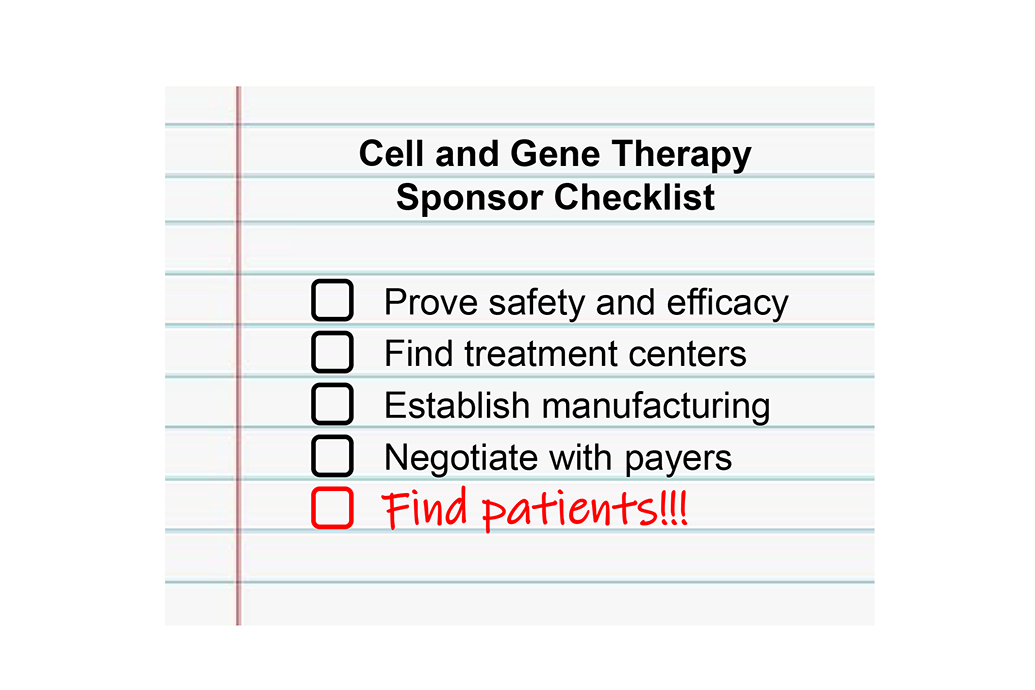
Blog | 8/22/2023
Patient Acquisition Challenges in Cell and Gene Therapy
Shay Pezzulo, Jeff Bessen, Ned Wydysh, PhD, and Vivek Mittal, PhD
Safety concerns, ethical considerations, controversial list prices, complex manufacturing, and difficult dosing – to the already daunting list of challenges faced by sponsors of cell and gene therapies, add patient acquisition.
Several recent news items have illustrated this challenge vividly. For example, Beam Therapeutics disclosed that it had yet to begin dosing in its phase 1/2 trial of BEAM-101 in sickle cell disease, which started a year ago. In an interview, Beam’s CEO cited a six-month process to prepare patients for treatment and one patient’s decision to withdraw from the trial as reasons for the delay. And patient acquisition challenges are not limited to clinical trials either: bluebird bio recently reported that only 16 patients have collectively been dosed with its gene therapies Zynteglo and Skysona, which were approved last year. Many other cell and gene therapy developers have silently faced similar challenges.
Given the pervasive nature of this issue, how can cell and gene sponsors avoid patient recruitment challenges? In this post, we will discuss strategies that companies may use to address such challenges across all stages of the drug life cycle.
Preclinical: Choice of Indication & Trial Design
Assessing the potential benefits and risks of a drug is an important consideration for any patient or provider. Such a risk-benefit analysis is especially relevant for cell and gene therapies, which have unique efficacy and safety profiles and are typically designed for patient populations with high unmet needs and limited treatment options. For gene therapies, for example, patients and clinicians will likely be wary of the risks inherent to one-time gene therapies compared to other modalities with less permanent effects, such as RNA interference (RNAi).
Accordingly, when prioritizing indications, it is crucial for companies to be aware of all the available and in-development drugs for each potential indication. Any indication worth prioritizing should have a compelling unmet need and strong clinical rationale within the context of both the future and current competitive landscapes (for more details on indication prioritization for gene editing therapies, refer to Health Advances’ white paper on Unlocking Potential Cures with CRISPR: Indication Selection And Portfolio Strategy For CRISPR-Based Gene Editing Companies).
Once a particular indication has been selected, companies should be sure to engage with the communities of each respective disease area to further understand the nuances of the patient and caregiver burden. Additionally, engaging with key opinion leaders, physicians, patients, and advocacy groups alike can be a powerful tool to design more effective studies. By having a comprehensive understanding of the patient journey and leveraging clinical expertise from seasoned physicians, companies are better equipped to select endpoints that are not only measurable but also clinically meaningful. Furthermore, designing a control group and choosing a study duration based on patient preferences can also help motivate participation.
Clinical Stage: Trial Recruitment & Ramping Up to Approval
During the clinical phase, companies should be proactive about using trials to build foundational relationships with treatment centers they plan to work with at a commercial level. In addition to the typical aspects of product launch, such as patient education, building key opinion leader networks, and dealing with any manufacturing bottlenecks, cell and gene sponsors will need to ensure that their treatment centers can provide the pre-treatment care and patient monitoring that their therapies may require.
Companies can also mitigate patient acquisition problems with active patient screening protocols. Orchard Therapeutics, for example, found success identifying patients pre-approval with its active newborn screening program for Libmeldy, an autologous hematopoietic stem cell gene therapy for early-onset metachromatic leukodystrophy. Leading up to Zolgensma’s approval in spinal muscular dystrophy (SMA) in 2019, Novartis championed patient advocacy group Cure SMA as they fought to include SMA in newborn screening panels.
Commercialization: Driving Adoption Post-Approval
Once approval has been secured, companies should continue active screening with full force to ensure a seamless transition to the commercial stage. After launching Libmeldy, Orchard expanded its newborn screening and diagnostic testing initiatives even further. Sarepta Therapeutics, which has already dosed its first patient a month after its approval earlier this summer for Duchenne muscular dystrophy, disclosed that it actively monitors patients approaching their sixth birthday to streamline dosing and effectively prioritize treatment recipients. Meanwhile, Novartis continues to support advocacy groups worldwide in promoting SMA screening among newborns. Now, Zolgensma is the most commercially successful gene therapy to date with over 3,000 patients treated globally.
In addition to active patient screening efforts, ramping up the number of qualified treatment centers is crucial in scaling up patient acquisition efforts. Bluebird bio, which has already established 15 treatment centers for Zynteglo and Skysona, plans to have a total of 50 centers up and running by 2024. Such a strategic expansion ensures that the therapies are accessible to a larger patient population. And, as we discussed earlier, building foundational relationships with treatment centers can and should be facilitated during the pre-approval phase.
Conclusion
Ensuring adequate patient recruitment can be a challenge for any cell and gene sponsor. As the industry progresses, however, we hope that strategies like thoughtful indication prioritization, careful trial planning, proactive relationship-building with treatment centers, and active screening can help mitigate such challenges and allow cell and gene therapy development to move forward with full force.
Authors
Shay Pezzulo, Analyst and member of the cell and gene therapy practice at Health Advances.
Jeff Bessen, Engagement Manager and member of the Cell and Gene Therapy practice at Health Advances.
Ned Wydysh, Vice President and Co-Leader of Health Advances’ oncology and cell and gene therapy practices.
Vivek Mittal, Partner, Managing Director, and Co-Leader of Health Advances’ oncology and cell and gene therapy practices.

